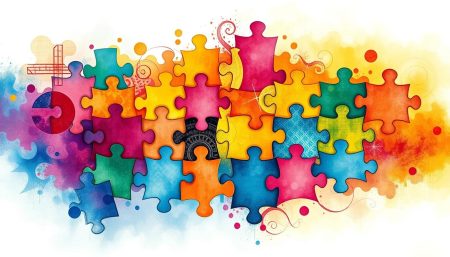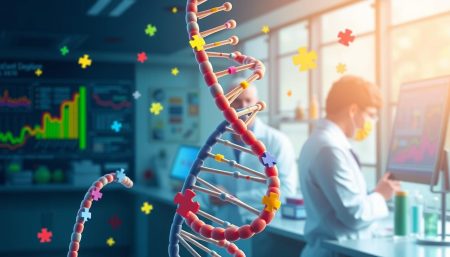Understanding autism spectrum disorder (ASD) is key to showing empathy and autism awareness. We aim to give a full understanding of ASD, showing its complexities and the need to see its subtleties. ASD is a group of neurodevelopmental conditions with unique communication, social interaction, and behaviors.
Our goal is to get to the core of the definition of autism spectrum disorder. We want to help families, teachers, and policymakers create supportive spaces. These spaces will help individuals with ASD grow and thrive.
To really get autism, we must see its wide range. It affects people differently, from social challenges to special strengths. As we move forward, we’ll look at autism’s key traits, diagnosis, and treatments. We’ll also look ahead to new research in autism.
What Is Autism Spectrum Disorder?
The definition of autism spectrum disorder (ASD) includes a range of neurodevelopmental disorders. These disorders affect social skills, speech, and repetitive behaviors. In the past, ASD was split into different conditions like autism and Asperger’s syndrome. Each condition had its own set of symptoms and severity levels.
As research has grown, so has our understanding of ASD. For those looking for help, more information is available at here. It explains how autism is different from mental health issues and why support is key.
It’s important to understand neurodevelopmental disorders like autism. They can greatly impact a person’s life and their family’s. With the right therapy, people with autism can improve their social skills and communication.
The journey to an ASD diagnosis can be tough for families. It’s a critical step in finding the right help for their needs.
- Individual assessments to understand behavioral and communicative traits
- Development of personalized therapy programs
- Continual support and adjustment of strategies based on developmental progress
The definition of autism spectrum disorder is deeply personal. It affects how people interact and grow every day. By understanding autism, we can create a more welcoming community for those affected.
Exploring the Definition of Autism Spectrum Disorder
Autism Spectrum Disorder (ASD) is a complex condition. It includes autism characteristics like trouble with social interaction and repetitive behaviors. It also affects how people communicate. It’s important to understand this condition and clear up myths about autism.
The Broad Spectrum of Autism
The spectrum of autism shows a wide range of symptoms and abilities. No two people with autism are the same. This means we need to tailor support and treatment for each person.
Myths and Misconceptions
Many myths about autism are harmful. They say autistic people can’t form emotional connections or are intellectually disabled. These are not true and hurtful. We need to understand autism better to support those on the spectrum.
There are also myths about autism and ADHD. To understand these, it helps to learn about ADHD and its effects. You can find more information atUnderstanding ADHD.
| Myth | Fact |
|---|---|
| Autism is just a behavioral disorder | Autism is a neurodevelopmental condition that affects brain development and functioning. |
| Each individual with autism has intellectual disabilities | Autism spectrum covers a wide range of skills, including many individuals with average to high intelligence. |
| People with autism do not have emotions | Individuals with autism can experience and express emotions but might communicate them differently. |
Key Autism Characteristics and Behaviors
Understanding the symptoms of autism is key for better support. Autism shows in repetitive behaviors and sensory sensitivities. These traits differ greatly from person to person.
- Repetitive Behaviors: These can be simple, like rocking or hand-flapping. Or they can be complex routines that must be followed exactly.
- Sensory Sensitivities: People with autism often react strongly to sounds, textures, or lights. This makes everyday places hard to handle.
Every person with autism is different. They show unique behaviors and sensitivity levels. This makes autism a wide range of experiences.
Spotting these traits early is very important. It helps manage symptoms of autism well. This way, those affected get the right help and support for their needs.
Neurodiversity and Neurodevelopmental Disorders
The idea of neurodiversity says we should get and love the differences in our brains. This includes autism spectrum disorders as just part of who we are. Looking at brain growth in a new way helps us accept different ways of thinking and acting.
Autism shows us how different our brains can be. Seeing it as part of neurodiversity changes how we view it. It’s not a problem, but a natural part of being human.
This change is key for schools and work places to support people with autism better. It helps everyone feel included and valued.
| Factors | Impact on Neurodiversity |
|---|---|
| Genetic Influences | Contribute to the vast spectrum of neurodevelopmental outcomes in individuals. |
| Educational Approaches | Adaptive educational practices that cater to diverse neurological needs can facilitate better learning experiences. |
| Social Acceptance | Understanding and accepting differences reduce stigma and enhance community inclusion. |
By seeing things from a neurodevelopmental perspective, we can make society better. We can create places where everyone is valued and supported. This is how we build truly welcoming communities.
Identifying Symptoms of Autism in Children
It’s important to spot early signs of autism and know about developmental milestones. This helps in getting a timely diagnosis. We’ll look at key behaviors and communication signs that might show autism in young kids.
Common Early Signs of Autism
Watching a child’s progress in key areas can show early autism signs. These areas include language, social skills, and adapting to new things. If a child is slow to reach these milestones, it might be time for a check-up.
- Limited use of gestures, such as pointing or waving
- Delayed speech development or, in some cases, regression in speech abilities
- Prefers playing alone and shows little interest in peer interactions

Communication and Social Interaction Red Flags
Children with autism often face challenges in talking and socializing. Spotting these signs early is key to getting help that can improve their life.
- Avoidance of eye contact
- Difficulty understanding social cues and nonverbal communication
- Limited sharing of interests or emotions, such as not showing objects or activities they enjoy
| Age | Expected Milestone | Signs of Concern |
|---|---|---|
| 12 Months | Babbling, gesturing (e.g., pointing) | Lack of gesturing or babbling |
| 24 Months | Two-word phrases, imitates others | Uses few or no words, does not imitate |
| 36 Months | Complex sentence formation, plays make-believe | Poor speech clarity, little pretend play |
By watching for these early signs and communication issues, parents and caregivers can know when to seek a diagnosis. It’s vital to talk to doctors if you’re worried about your child’s development. This way, you can start the right help early.
Understanding Autism Spectrum in Adults
The path to an adult ASD diagnosis is complex. It often comes later in life. For many, it reveals a journey filled with challenges and insights. It changes how they see themselves and manage their lives.
Looking into late diagnosis of autism helps understand past behaviors. It also leads to support tailored for each person. The diagnosis brings relief and anxiety as one learns to accept a new self.
Recognizing autism in adults can change lives. It brings self-acceptance and a sense of belonging. But, the journey to diagnosis is not easy.
- Increased awareness of adult-specific symptoms
- Access to diagnosis professionals proficient in adult autism
- Designing life adjustments post-diagnosis
Support for adult ASD diagnosis includes counseling and therapy. There are also community groups. These help adults diagnosed later in life reach their full potentials.
| Impact Area | Before Diagnosis | After Diagnosis |
|---|---|---|
| Personal Understanding | Limited self-awareness of ASD-related behaviors | Improved self-understanding and strategies for managing symptoms |
| Social Relationships | Challenges in social interaction and misunderstandings | Enhanced relationships through greater self-awareness and explanation of behaviors |
| Professional Life | Potential workplace misunderstandings and difficulties | Opportunities for appropriate adjustments and supports |
| Mental Health | Possible unaddressed anxiety and depression | Targeted mental health support and therapies |
The journey to a late diagnosis of autism is one of self-discovery. For many adults, it sheds light on past challenges. It opens the door to a deeper understanding of their lives and selves.
Process of ASD Diagnosis
Getting a formal autism diagnosis is a journey with key steps. It involves different diagnostic assessments. It’s important for parents, caregivers, and those who think they might have autism to know about these steps.
Professional Assessments for ASD
Getting a diagnosis of ASD starts with a detailed evaluation. This evaluation looks closely at the criteria for ASD. It’s done by healthcare experts who use detailed assessments to observe and interact with the person.
A team of experts is at the heart of this evaluation. This team might include psychologists, neurologists, and pediatricians. They work together to understand the individual’s behaviors and rule out other conditions.
Personal Stories and Self-Identification
Personal stories and self-identification are also key in diagnosing autism. Many start looking for answers when they notice certain behaviors that seem like ASD.
These stories are important for starting the assessment process. They also give context to the professionals. This helps them focus on the right behaviors during the assessments.
Understanding these stories helps professionals be more empathetic. This makes the diagnostic process more thorough and respectful of each person’s unique situation.
In the end, combining professional assessments with personal insights leads to a better understanding and accurate diagnosis of ASD.
Evidence-Based Autism Spectrum Treatment Options
Managing autism spectrum disorder (ASD) well needs evidence-based interventions. These methods are not the same for everyone. They are part of personalized therapy plans made just for each person. These plans help reach the best possible outcomes and improve life quality.
Autism spectrum treatment includes many proven therapies. These can be behavioral, educational, or medical, based on what each person needs. Here are some main parts of these treatments:
- Behavioral interventions that help good behaviors grow and bad ones shrink.
- Educational therapies that offer special teaching environments for each person’s learning style.
- Medical management, which might include medicines for issues like anxiety or trouble focusing.
Getting better usually starts with early diagnosis and starting evidence-based interventions right away.
| Intervention Type | Description | Typical Duration |
|---|---|---|
| Behavioral | Inclusive of strategies like Applied Behavior Analysis (ABA) | Ongoing, as needed |
| Educational | Special education services and supports | Custom to academic lifecycle |
| Medicinal | Management of co-occurring conditions | Varies based on medical advice |
These personalized therapy plans are made by teams of experts. They include therapists, educators, and doctors. Each plan is updated to meet new needs and use each person’s strengths.
The Role of Behavioral Therapy for ASD
Behavioral therapy for ASD, like Applied Behavior Analysis (ABA), is key for those on the autism spectrum. It uses proven methods to boost communication, social skills, and learning. This leads to real improvements over time.
Techniques and Strategies
ABA uses many techniques to fit each person’s needs. It includes methods like discrete trial training and positive reinforcement. These help encourage good behaviors and reduce bad ones.
- Discrete Trial Training: Teaches skills in small steps, intensively.
- Pivotal Response Training: Works on key areas like motivation and response to cues, improving learning.
- Positive Reinforcement: Rewards good behavior, making it more likely to happen again.
Measuring Progress over Time
It’s important to track how well therapy works for ASD. Regular checks and feedback help see how much progress is made. This also helps adjust the therapy plan as needed.
| Time Period | Skills Gained | Behavioral Improvements |
|---|---|---|
| 0-6 Months | Basic communication signals | Decrease in tantrums |
| 6-12 Months | Improved verbal skills | Enhanced social interactions |
| 1 Year+ | Advanced learning skills | Sustained positive behaviors |
Sticking to ABA’s structured methods leads to big changes. It helps learn important life skills. This way, people with ASD can live more independently and happily.
Navigating Communication Challenges in Autism
Good communication is key for learning and social skills, even more so for those with autism. People with autism face different communication challenges, from not speaking at all to needing special ways to talk. Learning the right autism communication strategies can make a big difference in their daily lives.
Speech therapy is very important for those who struggle to speak. It helps them learn to talk through practice and repetition. But, not everyone with autism can benefit from speech therapy alone. That’s why other methods are needed too.
- Visual aids such as picture boards
- Sign language
- Electronic communication devices
These tools help those who can’t talk to express themselves better. They make it easier for others to understand their needs and feelings.

Using these aids every day can really help with talking and understanding. Because everyone is different, mixing different strategies works best for most people.
| Strategy | Benefits | Recommended For |
|---|---|---|
| Picture boards | Enhances decision-making ability | Non-Verbal Autism |
| Sign language | Improves interpersonal communication | Those with coordination for hand gestures |
| Electronic communication devices | Customizable for individual needs | Wide range within autism spectrum |
Speech therapy and special communication tools help people with autism be more independent. They also help them fit in better with society. Support from family, teachers, and therapists is key to making these strategies work well for each person.
Autism in the School System
Schools need to create a supportive learning space for students with autism spectrum disorder (ASD). They should focus on inclusive education, offer strong autism accommodations, and provide special education services that meet each student’s needs.
Creating Inclusive Educational Environments
Inclusive education helps all students, not just those with ASD. It promotes diversity and understanding. Schools, parents, and specialists must work together to make classrooms welcoming for everyone.
Supporting Students with Autism Spectrum Disorder
Supporting students with autism goes beyond just schoolwork. It also means helping with social and emotional needs. This support often comes from individualized education programs (IEP) made by a team that knows the student well.
| Accommodation | Benefits | Implementation Strategy |
|---|---|---|
| Visual Aids | Enhances understanding and retention | Use of symbols and pictures in lessons and signage |
| Sensory Tools | Reduces stress and anxiety | Provision of sensory toys and quiet spaces |
| Communication Strategies | Improves interaction with peers and teachers | Training in alternative communication methods like sign language or PECs |
| Scheduled Breaks | Prevents sensory overload | Structured times for rest and relaxation |
By focusing on tailored autism accommodations and inclusive education, schools can empower all students. This approach sparks engagement and builds a supportive community. Special education services ensure every student’s journey is respected and supported, leading to success in school and life.
The Importance of Early Intervention
Early intervention for autism is key. It helps children with autism spectrum disorders grow better. Getting early childhood services and developmental therapies early on makes a big difference. It helps kids manage and overcome autism’s challenges.
- Early diagnosis and intervention lead to big improvements in communication and social skills.
- Special developmental therapies tailored for each child help develop important life skills.
- Early childhood services offer a supportive place for kids to learn and socialize through play.
These early steps are vital for the child and help families adjust to their child’s needs.
| Service | Description | Impact |
|---|---|---|
| Behavioral Therapy | Focuses on positive behaviors and reducing negative ones through consistent therapy sessions. | Improves social interactions and reduces behavioral issues over time. |
| Speech Therapy | Boosts communication skills through techniques that help with language and expression. | Increases confidence and helps express needs and feelings better. |
| Occupational Therapy | Helps develop everyday skills for independent daily activities. | Encourages self-sufficiency and improves quality of life. |
Being part of strong early intervention for autism programs is vital for young children. It focuses on their strengths and tackles challenges early. This way, early childhood services prepare kids for a lifetime of learning and adapting.
Starting developmental therapies early in life is essential. It changes the developmental path for kids with autism. It helps them reach their full growth and development as they get older.
Familial Support and Community Resources
Supporting a loved one with autism needs a full plan. This plan uses family support for autism and autism community resources. These help improve life for those with autism spectrum disorder (ASD). They create a network that supports understanding, acceptance, and action.
Networking and Support Groups
Connecting through autism community resources opens doors to services and emotional support. Support groups are key, letting families share and learn. They find comfort in knowing they’re not alone.
- Local Support Groups: Offer regular meetings and access to local resources.
- Online Forums: Connect families globally, breaking geographical barriers.
- Workshops and Seminars: Educate about autism care advancements and coping mechanisms.
Advocating for Public Awareness
Strong autism advocacy is vital. It helps people understand and supports inclusive policies. Advocacy pushes for better education, work places, and social interactions. This makes society more welcoming.
| Focus Area | Benefits | Goals |
|---|---|---|
| Education | Improved educational resources, tailored learning approaches | Inclusive curricula, teacher training on ASD |
| Employment | Job adaptations, supportive work environments | Increase workplace inclusivity, employment opportunities |
| Legal Framework | Enhanced protection and rights for individuals with ASD | Updated laws to incorporate ASD needs |
Families facing autism challenges need ongoing support. Family support for autism, autism community resources, and autism advocacy are key. They drive change and offer real help to those with ASD.
Technological Aids for Individuals with Autism
The use of assistive technology for autism has changed the game for those on the autism spectrum. It offers tools that improve communication, learning, and daily tasks. Communication devices and educational applications are key, making learning and interaction easier.
- Communication Devices: These are vital for those who struggle to speak. They allow users to express themselves through voice output and other methods.
- Educational Applications: These apps are made for the learning style of those with autism. They use fun content to teach various skills, from school subjects to everyday life skills.
These technologies help develop important skills and promote independence. They also help build confidence in users. Here’s a look at some popular tools in these areas:
| Category | Device/Application | Function |
|---|---|---|
| Communication Device | GoTalk | Pre-recorded messages for daily communication |
| Communication Device | Proloquo2Go | Customizable speaking assistant |
| Educational Application | Endless Alphabet | Interactive ABC learning tool |
| Educational Application | MathBoard | Math problem solving exercises |
In summary, assistive technology for autism like communication devices and educational applications has made a big difference. It has made learning and daily tasks easier for those with autism. It also helps them become more independent and successful. As technology keeps improving, the future looks bright for those with autism.
The Future of Autism Research and Development
As we move forward, the study of autism research advancements is very promising. Scientists are working hard to understand Autism Spectrum Disorder (ASD) better. They aim to find new ways to help people with autism.
They are looking into new methods that could change how we see and treat autism. This could lead to better ways to diagnose and treat each person. It’s all about finding what works best for each individual.
The field of future ASD therapies is getting a lot of attention. Researchers are using new technologies like brain scans and genetic tests. This helps them understand what causes autism.
They are working on new treatments that can be tailored to each person. Teams of experts from different fields are coming together. They are working on solutions that help with many autism challenges.
Supporting this research is important. It helps us learn more about autism and how to help those affected. It’s a step towards a better life for people with autism, where they are understood and included.
FAQ
Q: What exactly is Autism Spectrum Disorder?
A: Autism Spectrum Disorder (ASD) is a complex condition. It affects how people interact, communicate, and behave. It includes what were once separate conditions like classic autism and Asperger’s syndrome.
Q: How is ASD diagnosed?
A: Doctors look at how a person talks, acts, and interacts with others to diagnose ASD. They use screenings and evaluations by a team of experts. They also use special tools to help make a diagnosis.
Q: What are some early signs of autism in children?
A: Early signs include delayed speech and not making eye contact. Children might not respond to their name or show little interest in others. They might also struggle with changes in routine.
Q: Can adults be diagnosed with ASD?
A: Yes, adults can get diagnosed with ASD. This can happen for many reasons. These include better understanding, new diagnostic tools, and symptoms that were missed before.
Q: What are some common myths about autism?
A: Many myths exist about autism. Some say all people with autism have low intelligence or special talents. Others believe vaccines cause autism or that they don’t want to be social. These are all false and cause confusion.
Q: What treatment options are available for autism spectrum disorder?
A: Treatments vary based on the person’s needs. They might include behavioral therapy, speech and occupational therapy, and educational help. Medication can also be used to manage symptoms like anxiety.
Q: How does behavioral therapy for ASD work?
A: Behavioral therapy uses techniques like Applied Behavior Analysis (ABA). It rewards positive behaviors and skills. The therapy is tailored to each person and constantly adapts to their progress.
Q: What techniques assist with communication challenges in autism?
A: To help with communication, strategies like speech therapy and visual aids are used. Social skills training and assistive technologies also play a role. They help with both verbal and non-verbal communication.
Q: Why is early intervention important?
A: Early intervention is key because young children’s brains are more adaptable. It helps them make progress in important developmental areas. This can lead to significant improvements and better outcomes in the long run.
Q: What role do technology and applications play in supporting individuals with ASD?
A: Technology and apps offer tools that help with learning and communication. They include devices for communication, educational apps, and tools for sensory integration. These tools can greatly improve independence and quality of life.
Q: How can families support a relative with ASD?
A: Families can be very supportive. They can be involved in therapy, learn about ASD, advocate for their loved one, and join support groups. This helps connect with others and find resources.
Q: What resources are available for educators to support students with autism?
A: Educators have many resources. They can access special education services, IEP planning guides, and training on inclusive education. They also have accommodations to help students with ASD in school.
Q: What is neurodiversity and how does it relate to ASD?
A: Neurodiversity is about accepting and valuing neurological differences. It includes conditions like ASD and promotes supporting individuals to live fulfilling lives. It’s about recognizing and valuing diversity in the brain.
Q: What advancements are happening in autism research?
A: Research on autism is always evolving. Studies are looking into genetics, early detection, and new treatments. There’s also a focus on understanding adults with autism and improving support services.


















